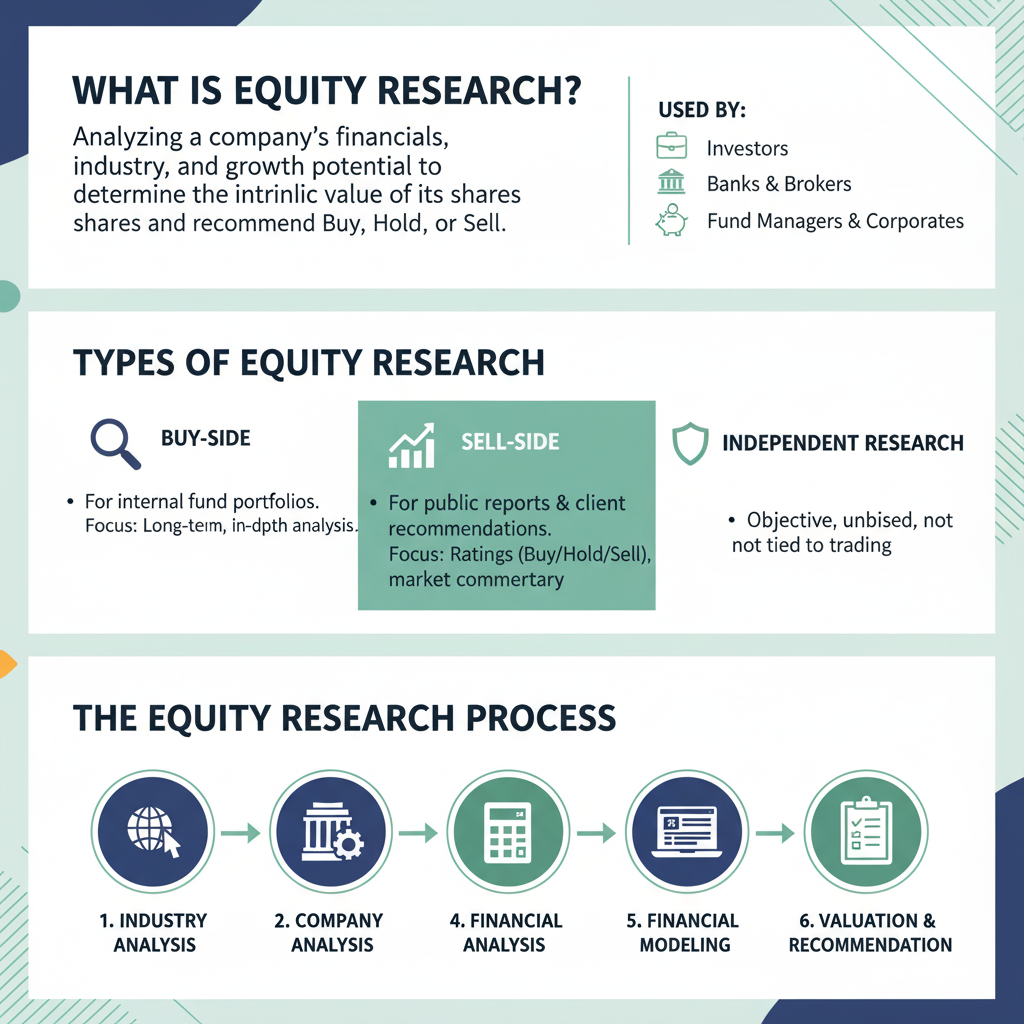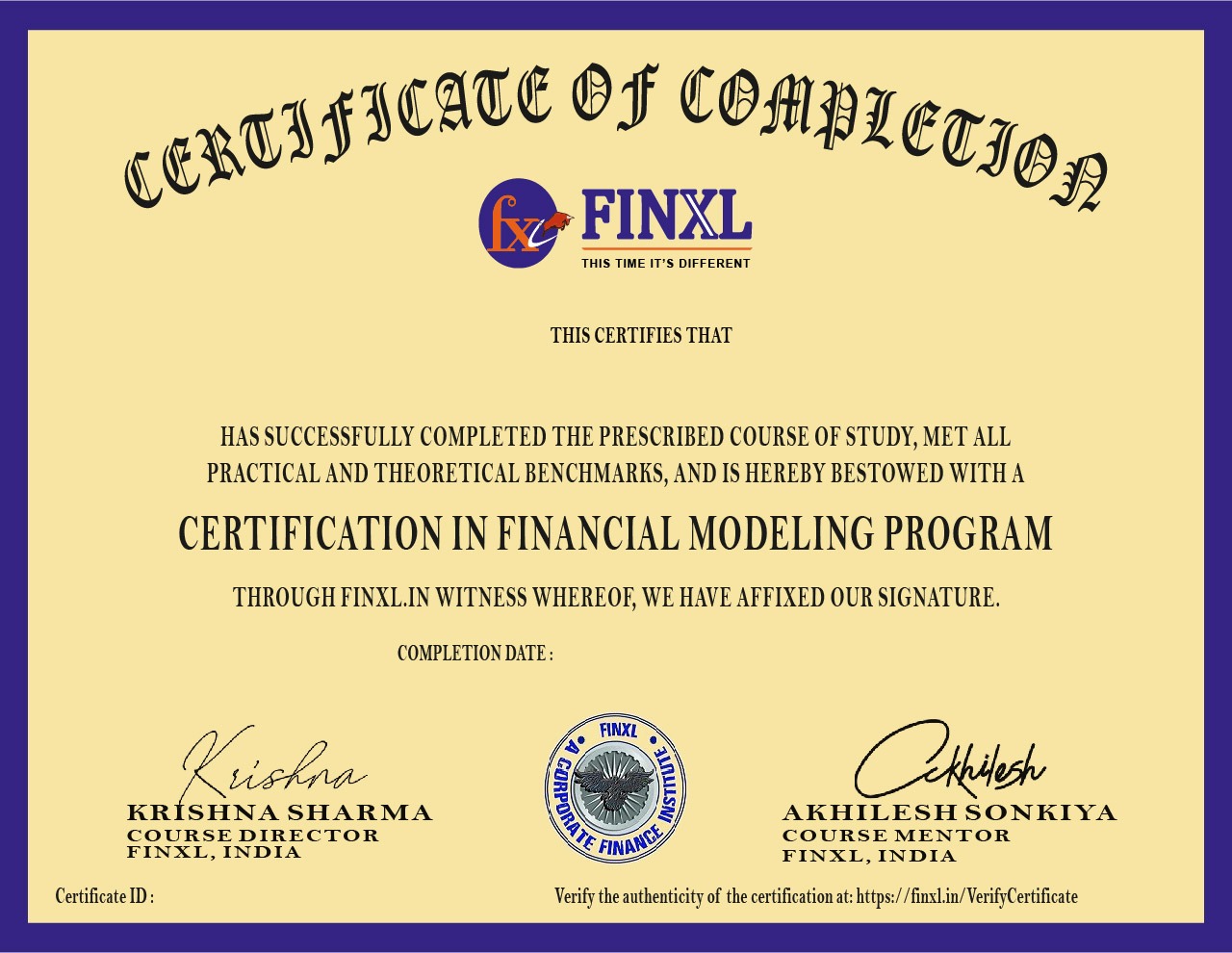Equity Research: Definition, Process & Careers
Introduction to Equity Research
The stock market is one of the fastest moving and most dynamic spheres of finance. There is a thorough process that involves due diligence or analysis, which we will refer to as Equity Research, whether you see an investment recommendation on a television news program, a stock rating in a financial magazine or an analyst's report analyzing the public company's stock. Equity Research is not just predicting whether a stock will either go up or down, it involves an examination of a company, its industry, financial performance, management strategic, risk, and growth potential. The examination that is taken in Equity Research will allow an investor to act with confidence on whether to buy or sell a stock. In addition, for the professionals involved, Equity Research unlock solutions to careers with strong salaries in Finance.

What is Equity Research?
Equity Research is the effort made to scrutinize a company's financial health, function, position in its industry, and the potential growth of that company to arrive at an intrinsic value for its shares. The ultimate aim is to make a recommendation about whether or not investors should buy, hold or sell shares in that company.
Put simply, equity research determines the real value of a company's shares.
👉 Example: If the market price for a company's shares is ₹500, but an equity analyst estimates the intrinsic value to be ₹650, he or she would likely recommend Buy. If that same analyst estimates the intrinsic value to be ₹400, the analyst would probably recommend Sell.
Equity research reports are regularly used by:
- Investors - to inform better decisions.
- Banks & Brokers - to advise their clients.
- Fund Managers - to direct and allocate investment for their portfolio.
- Corporates - to understand how the market perceives them.
Why is Equity Research Valuable?
Equity research provides a foundation in capital markets that enhances transparency, trust, and efficiency. Without equity research, most forms of investing would be purely gambling.
Here are the key reasons why it is important:
- 1. It promotes informed investing: Investing is based on facts, not guesswork. Research reports establish the rationale why a company’s stock is under or overvalued, providing the investor with confidence.
- 2. It facilitates price discovery: Equity Research price orders or estimates for specific names through valuations and analysis to ensure that stocks reflect their value over the long term.
- 3. Risk identification: Equity analysts seek out risks- for example, declining revenue, balance sheet or debt issues, competitive pressures- that may lead investors to make poor investment decisions prematurely.
- 4. It fosters market efficiency: More accurate information means more equitable markets.
- 5. It may be very significant for corporate strategy: Corporations themselves keep track of analyst reports and their opinions regarding company outlook in order to monitor the market’s perception of their performance outcomes.
📌 In summary, equity research connects the dots between raw financial information and real-world investment decisions.
Types of Equity Research
There are two main types of Equity Research categorized based on who produces it, and their purpose.
1. Buy-Side Equity Research
- Produced by: Asset Management Companies, Mutual Funds, Pension Funds, Hedge Funds.
- Goal: Producing returns in excess of market rates in connection with the funds own portfolio.
- Main focus: In-depth analysis over a long time period, trade secrecy.
2. Sell-Side Equity Research
- Produced by: Investment Banks, Brokerage Firms.
- Goal: Publicate reports and recommendations to clients.
- Main focus: Get reported ratings like Buy, Hold, or Sell, provide commentary on that market, earnings claims and forecasts.
📌 For example, if a mutual fund goes out and does research on IT stocks, that is buy-side research. However, if a investment bank publishes a public report rating Infosys as a "Outperformer", that is sell-side research.
3. Independent Equity Research
- Conducted by boutique research firms or independent analysts.
- Tends to be more objective as it is not supplementing trading revenue.
4. Thematic Equity Research
- Focuses on a sector or trend (e.g., green energy, fintech, AI stocks).
- Beneficial for investors who prefer to bet on megatrends.
The Equity Research Process Step by Step
The Equity Research process is thorough and systematic; analysts use a methodical approach to ensure accuracy.
- Step 1: Industry Analysis
Understand the overall performance of the sector.
Research the demand, supply, regulations, and global trends.
Example: When researching an automobile stock, consider the adoption of EV (electric vehicle) technology, gas prices, and government policies. - Step 2: Company Analysis
Understand the business model, products, management, and market share.
Conduct a SWOT (strength, weakness, opportunity, threat) analysis. - Step 3: Financial Statement Analysis
Income statement: Revenue, profit margins
Balance sheet: Debt, assets, and liabilities.
Cash Flow: liquidity and sustainability of the operations. - Step 4: Ratio Analysis
P/E Ratio (Price-to-earnings ratio).
ROE (Return on equity).
Debt-to-equity.
Current ratio. - Step 5: Financial Modelling
Build models using excel or services like Bloomberg. The common models include:
Discounted Cash Flow (DCF) analysis.
Comparable Company Analysis.
Precedent Transaction Analysis.
Three-statement Model. - Step 6: Valuation
Determine a fair value or target price based on calculations and compare it to the current market price. - Step 7: Investment Recommendation
Finally, make a recommendation based on your calculations of whether to buy (if the stock is undervalued), hold (if it is fairly priced), or sell (if it is overvalued).
Example: Suppose Tata Motors trades at ₹700, but your values indicate that it should be priced at ₹850. The recommendation made by the analyst = buy.
Skills Required for Equity Research
While there is a high demand for equity research analysts, it is also a fairly tough role to undertake. The role requires a combination of both technical and soft skills.
Technical Skills
- Strong knowledge of accounting and finance.
- Ability to build financial models and develop ways to value securities.
- Understanding of Excel, PowerPoint, Bloomberg, Reuters, Capital IQ etc.
- Fluency in some programming languages (Python/R) for quantitative & data-based research.
Soft Skills
- Analytical and critical thinking.
- Ability to communicate complex ideas in simple ways.
- Communication skills (for writing reports)
- Attention to detail.
Tip for Students: Start with Excel modelling. Once you are comfortable with the modelling process, start learning DCF valuation and comparable analysis.
Career in Equity Research
Equity research represents a few of the highest paying jobs in finance.
Common Roles
- Equity Research Analyst – Analysts responsible for valuing a stock and giving a recommendation for it.
- Research Associate – Entry-level; assists senior analysts and builds financial models.
- Portfolio Manager – Responsibilities include deciding how to allocate funds.
- Buy-Side Analyst – Works for mutual funds and hedge funds.
- Sell-Side Analyst – Works for an investment bank.
Salary Overview
- India – ₹6 – ₹18 LPA (based on experience level of analysts)
- US/UK – $70,000 – $150,000 a year.
Top Firms Hiring: JP Morgan, Goldman Sachs, Morgan Stanley, ICICI Securities, Motilal Oswal, Axis Capital.
Pro Tip: To have greater earning opportunities, having certifications such as CFA, FRM, or MBA (Finance) is hugely beneficial.
Tools Used in Equity Research
Today's equity research is data-driven. Analysts use several sophisticated tools and resources:
- Bloomberg Terminal – Real time financial data.
- Thomson Reuters Eikon – for analyzing market data.
- FactSet and Capital IQ – for valuating and screening investments.
- Excel and VBA – for building modelling
- Python and R – for big data and quantitative research.
Life of an Equity Research Analyst
The day-to-day life of an equity research analyst is a very intensive combination of market analysis, financial forecasting, and client interaction. Ultimately, the analyst's objective is to provide valuable research and investment suggestions for institutional investors or clients. This responsibility requires an analysis background with a high degree of discipline and the ability to make sense of a large amount of information very quickly.
Key Responsibilities & Key Deliverables
An analyst's work revolves around a schedule of key deliverables.
- 1) Daily: Morning notes are provided as a daily deliverable, which are quick summaries of any market-moving news, important headline announcements, and trading ideas. Morning notes are usually required when the market opens for that region.
- 2) Weekly: Sector updates are mostly published weekly, which track trends, news, and performance of their respective industries.
- 3) Quarterly: Quarter reports tend to be the peak workload periods for an analyst, because of the emphasis around a company earnings report announcement. This means that analysts will update their financial models, and publish new research reports to document their last update or reporting.
- 4) Event-Based: Ad-hoc reports are published following specific events that happens to their coverage universe, which typically are in response to material events like mergers & acquisitions (M&A), large corporate announcements, and economic/fundamental shifts.
The Analyst's Daily Workflow
The trading day is organized into different phases, each with its own tasks and tools
Pre-Market Preparation
The day starts long before markets open. Analysts must be ready to take on the day's trading tasks.
- Global Market Scan: Analysts look at market performance overnight from Asia and Europe, checking global indicators, currencies, commodity prices, and bond yields.
- News & Filings: Analysts check corporate news wires for announcements, new research, insider activity, and regulatory filings (8-K, 10-Q, 10-K) that could impact the companies they cover.
- Morning Note: They summarize their findings in a Morning Note, which includes headlines, previous day's movers, and trading ideas for the day.
- Tools of the Trade: This stage heavily relies on professional data terminals like Bloomberg, Reuters, and FactSet, as well as real-time data from exchanges like the NSE and BSE.
Research & analysis
After the market opens, analysts engage in deep dive research projects.
- Top-Down and Bottom-Up: Analysts use a two-pronged approach, analyzing the industry as a whole (top-down) and the fundamentals of individual companies (bottom-up).
- Data Gathering: They pull data from company filings, industry publications, and primary research like discussions with industry experts.
- Company Deep Dive: This includes analyzing the company's business model, competitive landscape, key metrics (like ARPU), management quality, and corporate governance.
- Building the Investment Thesis: The goal is to create a compelling narrative explaining why a stock is projected to move, outlining the drivers, catalysts, and risks.
Financial Modeling & Valuation
This is the quantitative core of the role, translating research into numerical forecasts.
- Model Hygiene: A well-built financial model is organized, with separate tabs for assumptions, full linking, and built-in checks for accuracy.
- Forecasting: Analysts project a company's three financial statements (Income Statement, Balance Sheet, Cash Flow) by forecasting key drivers like customer growth and pricing.
- Valuation Methods: Common methods to estimate a stock's intrinsic value include:
- Discounted Cash Flow (DCF): Values a company based on the present value of its future cash flows.
- Comparable Company Analysis (Comps): Compares valuation multiples (e.g., P/E, EV/EBITDA) against similar publicly-traded companies.
- Sum-of-the-Parts (SOTP): Values each business segment of a conglomerate separately and adds them together.
Reporting and Client Interaction
The final step is communicating findings in a coherent way.
- Report Structure: A research report typically includes an executive summary, investment thesis, financials, Valuation, catalysts, risks, and a compliance appendix.
- Recommendation: The report concludes with a Buy, Hold, or Sell recommendation, along with a price target and time horizon.
- Visuals: Good reports use charts and tables (e.g., Valuation bridges, KPI charts) to present complex information clearly.
- Client Presentations: Analysts regularly present their research to clients, focusing on the thesis and being prepared to answer tough questions concisely.
Financial Modeling Certification
The Financial Modeling Certification program is designed to provide you with in-demand industry knowledge, hands-on practice, and confidence to stand out and become a world-class financial analyst.
Enroll Now
